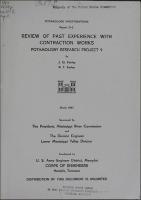Please use this identifier to cite or link to this item:
https://hdl.handle.net/11681/3163| Title: | Review of past experience with contraction works : Potamology Research Project 9 |
| Authors: | United States. Mississippi River Commission United States. Army. Corps of Engineers. Lower Mississippi Valley Division United States. Army. Corps of Engineers. Memphis District Fairley, John G. Easley, Robert T. |
| Keywords: | Potamology Mississippi River River banks Bank stabilization River contraction Contraction structures Hydraulic structures River improvement Dikes |
| Publisher: | U.S. Army Engineer Waterways Experiment Station. Engineer Research and Development Center (U.S.) |
| Series/Report no.: | Potamology investigations report ; 21-2. |
| Description: | Potamology Report Summary: This report covers the history of past projects for the stabilization of the Mississippi River channel by contraction, or the use of structures designed to contract and contain the low-water navigation channel in a desirable alignment, with depths sufficient for navigation. The report presents a comprehensive account of the construction, development, and results of contraction works in the Memphis District prior to the present channel improvement project. Most of these efforts were concentrated within two relatively short periods of time in the course of Mississippi River stabilization: the improvements in the Plum Point, Tennessee, reach between 1881 and 1888; and the 1929-1937 program, which included 28 dike systems throughout the Memphis District. The report also describes some miscellaneous structures tried, for various purposes, in the past. The study consisted of a review of numerous reports, correspondence, notes, maps, and specifications relating to past practices in river regulation, and analyses of their effectiveness with respect to the original condition and history of the reach, and to the initial design, location, and development of the dike systems. The contraction efforts in the Plum Point reach involved the use of newly developed structures, and the project was beneficial mainly as an experimentation in stabilization methods. As such it provided useful information for later planning and improvements in structure design. The 1929-1937 project was benefited by improved structures and was successful at some locations. Of the systems that failed completely, some of the causes were the lack of advanced study and planning, attempts to combat rather than assist in the natural development of the river in a reach, and improper location of the systems and individual dikes. The most important contributing factor, however, to the ineffectiveness of most of the systems was the failure on the part of the planners to take advantage of the initial improvements by following through with supplementary dikes and additional stabilization works through a reach as the channel developed. |
| Rights: | Approved for public release; distribution is unlimited. |
| URI: | http://hdl.handle.net/11681/3163 |
| Appears in Collections: | Potamology Investigations Report |
Files in This Item:
| File | Description | Size | Format | |
|---|---|---|---|---|
| Potamology-Investigations-Report-No.-21-2.pdf | 18.46 MB | Adobe PDF |  View/Open |